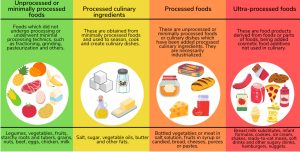29 Aug Ultra Processed Food
This article covers “Daily Current Affairs” and the topic details “Ultra Processed Food”. The topic “Ultra Processed Food” has relevance in the “Public Health” section of the UPSC CSE exam.
For Prelims:
What is Ultra Processed Food?
For Mains:
Concerns with Ultra-Processed Food?
Way forward?
GS 2: Public Health
Why in the news?
A joint report by the World Health Organization (WHO) and the Indian Council for Research on International Economic Relations revealed that the Ultra-Processed Food Sector in India experienced a Compound Annual Growth Rate (CAGR) of 13.37% in terms of retail sales value between 2011 and 2021.
What is Ultra Processed Food?
- Ultra-processed food is a category of highly transformed food products that goes beyond regular processing. It typically involves adding salt, sugar, and fat for enhanced flavor, but what sets it apart is the incorporation of five or more additional ingredients to the original product.
- These extra components often include flavor enhancers, emulsifiers, colors, and preservatives, all aimed at improving taste, prolonging shelf life, and providing convenience.
Examples:
- Unprocessed: Raw atta (flour).
- Processed: Dalia (porridge) with added salt and sugar.
- Ultra-processed: Cookies made from atta with various additional ingredients.

Concerns with Ultra-Processed Food:
Health Problems:
- Regular consumption of foods with added salt, sugar, and fat can lead to health issues. Health risks include obesity, hypertension, cardiac problems, and lifestyle diseases.
- Artificial chemicals in ultra-processed foods can negatively impact gut health. Gut imbalance can result in neurological problems, stress, mood swings, and obesity.
Addictive Nature:
- Many ultra-processed foods use taste enhancers, contributing to addiction. People can become automatically addicted to these foods due to their enhanced flavors.
- These foods are designed to be broken down quickly and absorbed efficiently. This rapid absorption can lead to a swift increase in blood sugar levels, which can trigger a release of dopamine, a neurotransmitter associated with pleasure and reward.
Sugar’s Role:
- The rapid release of insulin in response to high sugar intake can lead to a subsequent drop in blood sugar levels. This drop in blood sugar can result in a feeling of increased hunger and a desire to eat more. This is often referred to as a “sugar crash.”
- Repeated consumption of sugary foods can lead to a desensitization of the brain, making you crave even more sugar to achieve the same pleasurable feelings. This can contribute to a cycle of consumption and cravings.
Temporary Disruption and Rebounded:
- The Covid-19 Pandemic caused a temporary disruption in the Indian ultra-processed food sector.
- Annual growth rate dropped from 12.65% in 2019 to 5.50% in 2020 due to the pandemic’s impact.
- The sector rebounded remarkably with an impressive 11.29% growth recorded in 2020-2021.
Dominant Categories and Sales Volume:
- Notable ultra-processed food categories include chocolate and sugar confectionery, salty snacks, beverages, ready-made and convenient foods, and breakfast cereals.
- In the period from 2011 to 2021, beverages held the largest share in terms of retail sales volume. This was followed by chocolate and sugar confectionery, and ready-made and convenience foods.
Health Consciousness and Changing Consumption Patterns:
- Health-conscious consumers shifted their preferences during the pandemic.
- Carbonated sugar-sweetened beverages saw decreased demand, while fruit and vegetable juices gained popularity possibly due to perceived immune-boosting properties.
- However, alternative beverages like fruit and vegetable juices might also contain high levels of free sugars.
Stricter Advertising and Marketing Regulations:
- Implement stricter regulations on advertising and marketing, especially for products like sweet biscuits that attract children.
- Address the health risks posed by high salt content in salty snacks through regulatory measures.
Clear Definition of High Fat Sugar Salt (HFSS) Foods:
- Collaborate with stakeholders to establish a precise definition of High Fat Sugar Salt (HFSS) foods.
- Link the tax structure to the HFSS definition via the GST Council to promote healthier options by imposing higher taxes on products surpassing recommended fat, sugar, and salt levels.
Way forward:
Comprehensive National Nutrition Policy:
- Develop a comprehensive national nutrition policy that addresses both under- and over-nutrition.
- Ensure the policy’s objectives and targets are well-defined, achieved through extensive consultations with stakeholders.
- Enhance existing policies like Saksham Anganwadi and Poshan 2.0 to encompass overnutrition and diet-related diseases comprehensively.
Nutritional Transition and Long-Term Goals:
- Encourage a shift toward healthier lifestyles by advocating reduced consumption of ultra-processed foods and increased intake of whole grains.
- Recognize the low intake of whole grains as a primary dietary risk factor for noncommunicable diseases in India.
SOURCE: https://www.downtoearth.org.in/news/health/india-s-ultra-food-processing-sector-growing-who-calls-for-nutrient-based-tax-model-91336
plutus ias current affairs eng med 29th August 2023
Q.1 Which of the following characteristics are associated with ultra-processed foods?
- Typically contain only three main ingredients.
- High content of added salt, sugar, and fat.
- Quick breakdown in the body, leading to slow absorption of nutrients.
How many of the above statement/s is/are correct?
(a) Only one
(b) Only two
(c) All three
(d) None
ANSWER: C
Q.2 Discuss the concept of ultra-processed foods and their implications on public health. Examine the factors that contribute to the addictive nature of such foods, and suggest policy measures to address the challenges posed by their consumption.



No Comments